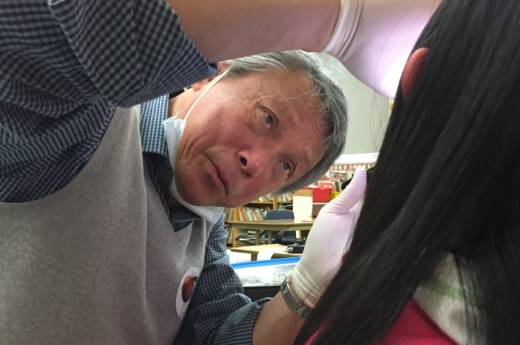That’s why the program has ramped up its efforts in and around Chinatown. In addition to screening kindergartners, most of these schools screen second and fifth graders too. The Department of Public Health also offers expanded access to free fluoride treatments and sealants. Volunteer dentists from the San Francisco Dental Society lead the exams.
At Spring Valley Science Elementary School near Chinatown, it was screening day, and students waited for their turn to say “aaah!” The line snaked down the hallway. Students joked and fidgeted outside the multipurpose classroom where dentist Richard Choi perched on a tiny classroom chair, peering into mouth after mouth with a flashlight and tongue depressor. Sherry, a second-grader with straight black hair, stepped forward.
"Open wide," Dr. Choi says, "let me take a look up on top." He counted out loud how many fillings, cavities, and missing teeth Sherry had. A public health official sat across the table from Dr. Choi, logging the results.
Among other things, public health officials are concerned about children's teeth because poor oral health can affect a child’s diet, ability to concentrate and do well in school, and self-esteem.
Kent Woo runs the nonprofit NICOS Chinese Health Coalition. It focuses on the health of San Francisco’s Chinese community.
He said Asian-Americans “are oftentimes thought of as a model minority, that we have no problems. We do well, regardless. And yet here is just a very glaring health disparity."
Woo and his colleagues are trying to understand the causes of that disparity in oral health. Recently, he met with other community health organizations that focus on San Francisco's Chinese residents, to hear results from a focus group that health worker Christina Nip ran.
Nip found that the participants, who all live in Chinatown, understood the importance of brushing, flossing, going to the dentist, and avoiding sugar. But she also discovered that they mostly waited to call a dentist after they had already developed a dental problem.
“Back in the home country there’s a lack of emphasis on oral health,” Nip said, referring to China.
The focus group members told her that even in a country that does emphasize preventative visits, it’s not easy to go to the dentist. It’s hard to find one within a specific insurance plan, especially one that may speak their language. For some, it can be prohibitively expensive. Some focus group participants expressed concern that a visit to the dentist for a very young child would be too scary for them.
Tap water was also a concern. "Many of them actually are not comfortable drinking tap water," Nip said. That’s an issue because tap water contains fluoride, which has been shown to help prevent cavities.
Some said they have heard it's fine to drink tap water in San Francisco, but when they turn the water on, the water that emerges for a few moments is discolored.
Nip, Woo and their colleagues will use all this information to develop new messages and strategies. Some proposals include having doctors bring up oral health with new moms during post-partum check-ups, and and doing outreach at churches.
After the screening at Spring Valley, the children get a sticker reminding them to “brush, floss, smile.” Dr. Choi has screened 145 kids in less than four hours. Later in the week, a dental hygienist will come back to the school and apply free sealants to the teeth of children who need them.
Spring Valley’s principal, Marlene Callejas, praised the program. She recalled one student, newly arrived from Yemen, who was suffering from an infected cavity.
"He wanted to spend time out of the class," Callejas said. "He was crying, he couldn’t focus on paper that was in front of him, he was just in a lot of pain."
After the student went to the dentist, Callejas said, things turned around. He could concentrate, and he started learning English faster.
